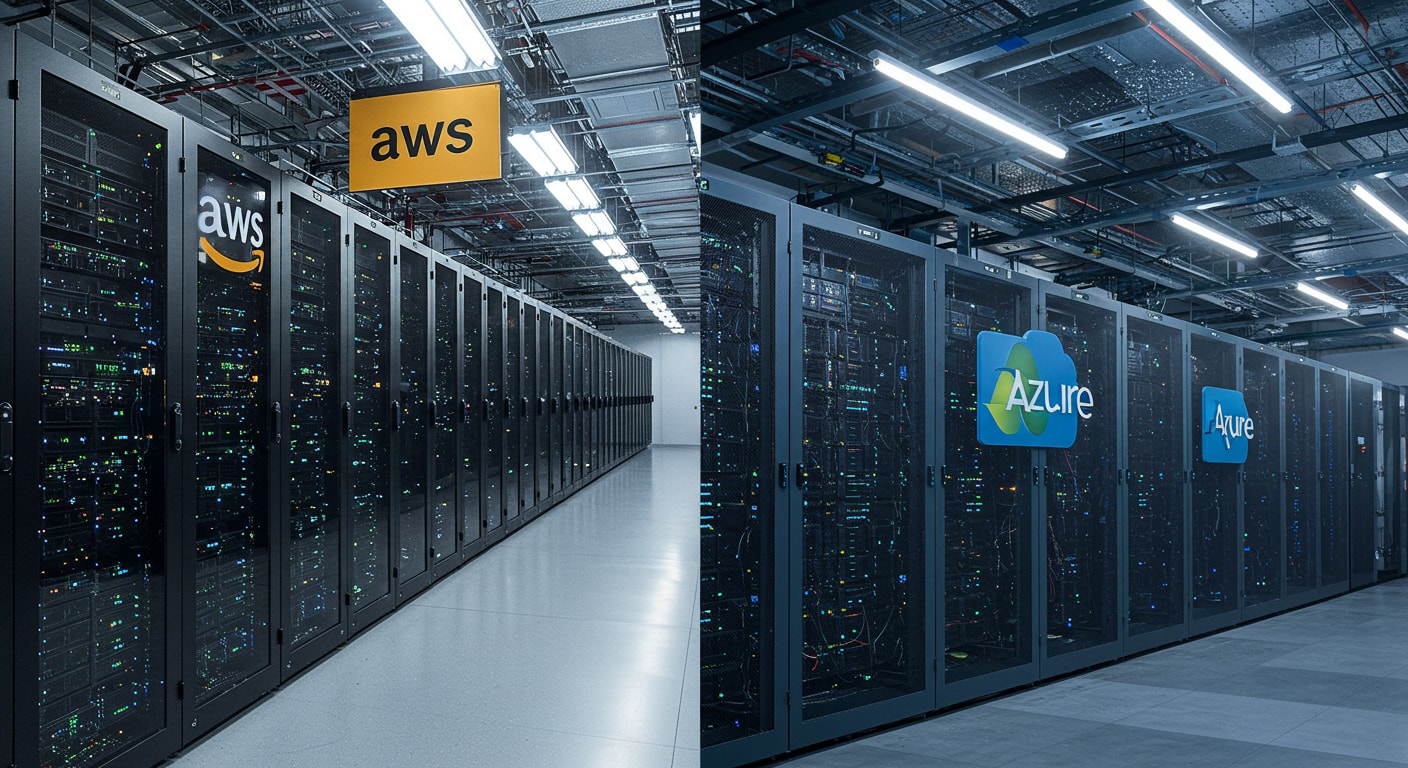The cloud world is no longer defined by adoption — it’s defined by optimization. You’re no longer asking if you need cloud infrastructure. You’re asking which provider will give you the most control, security, and value as your needs grow.
Two names dominate that conversation: Amazon Web Services (AWS) and Microsoft Azure. These platforms account for the lion’s share of global cloud activity and serve as the backbone for everything from enterprise workloads to AI experiments.
With hybrid cloud solutions gaining momentum and budgets under tighter scrutiny, choosing the right cloud partner isn’t just strategic — it’s essential. This article breaks down the key differences between AWS and Azure so you can make an informed decision rooted in practical considerations, not just brand recognition.
What Are Azure and AWS—and Why Are They Dominating the Cloud Market?

Amazon Web Services (AWS)
Launched in 2006, AWS pioneered cloud computing as a mainstream business tool. It grew from a few basic services into a sprawling ecosystem that supports millions of users across the globe. AWS offers data centers in more regions than any other provider, giving you near-unmatched global coverage and latency control. It has long held the lead in cloud market share, particularly among startups, developers, and compute-heavy enterprises.
Microsoft Azure
Azure arrived later, but its impact has been fast and deep — especially among large organizations. What makes Azure distinct is its tight integration with Microsoft products. If your business already relies on tools like Windows Server, SQL Server, or Microsoft 365, Azure offers a more natural fit. It’s also at the forefront of hybrid cloud development, blending cloud and on-premises environments with relative ease.
The Bigger Picture
So why do AWS and Azure dominate the conversation? It comes down to trust, reach, and breadth of service. They serve overlapping markets, but with different philosophies and strengths. Google Cloud and other players have their merits, but the AWS–Azure rivalry remains the focal point for most enterprise and institutional buyers. If you’re weighing cloud strategies, chances are high that both names are on your shortlist — and understanding how they stack up is your next best move.
How Do Their Compute Services Compare?
When it comes to compute services, AWS and Azure both offer powerful, flexible platforms that let you run applications, scale infrastructure, and automate workloads — but how they deliver those experiences differs in a few key ways.
Elastic Compute Options
AWS offers Amazon Elastic Compute Cloud (EC2), which lets you spin up virtual machines (VMs) with a wide range of configurations. You can tailor compute power, memory, and networking to match your workload, whether it’s a lightweight web app or a GPU-heavy rendering job. Azure counters with Azure Virtual Machines, offering similar flexibility but with closer ties to Microsoft tools and enterprise environments.
Performance in both platforms is strong, but provisioning differs slightly. EC2 often requires more initial configuration, while Azure’s interface may feel more familiar if you’re used to Microsoft systems.
Pricing and Flexibility
AWS provides a broader menu of pricing tiers — from on-demand instances to Spot Instances (unused capacity at discounted rates) and Reserved Instances for predictable, long-term use. Azure offers similar models, including its own reserved instance pricing and fast provisioning.
Both providers support auto-scaling, allowing your infrastructure to expand or contract based on demand — which is crucial for cost control and consistent performance.
Modern Use Cases
In the serverless category, AWS Lambda and Azure Functions both let you run event-driven code without managing servers. These services are ideal for automation, real-time data processing, or lightweight APIs.
Compatibility also matters. AWS has broader third-party support, but Azure often integrates more seamlessly with on-premises environments, especially for organizations already running Microsoft workloads.
What About Storage—Which Cloud Offers Better Options?

Storage is where the real test of a cloud provider’s infrastructure comes into play. Whether you’re archiving terabytes of data or serving files to thousands of users, you need storage that’s fast, scalable, and secure.
Storage Types and Performance
At the object storage level, you’re likely choosing between Amazon S3 and Azure Blob Storage. Both are highly scalable, durable, and optimized for big data. Amazon S3 has a longer track record and deeper integration with AWS services, while Azure Blob shines in environments using Microsoft analytics or business intelligence tools.
For block storage (used to support virtual machines), AWS provides EBS Volumes, which offer high-performance storage tightly integrated with EC2. Azure’s counterpart is Azure Managed Disks, designed for consistent throughput and easy backups.
Need archival storage? AWS has Glacier, and Azure offers Cool and Archive tiers — both focused on long-term retention at a lower cost.
Use Case Scenarios
If you’re working with media content, both providers deliver on performance and throughput. Azure’s media services pair well with its storage for streaming workflows, while AWS has deeper CDN (content delivery network) integrations.
For disaster recovery and backup, both offer replication across regions, automated failover options, and tools to ensure data availability even under heavy load. Your decision will likely hinge on your existing stack — and whether integration with other tools matters more than interface or branding.
Which Cloud Has a Better Pricing Model and Cost Structure?
Cloud pricing is notoriously complex. While both AWS and Azure offer competitive pricing, the details can get murky — especially when factoring in usage patterns, reserved capacity, and hybrid deployments. Understanding the core models will help you avoid surprise bills and better predict long-term costs.
On-Demand vs Reserved
Both AWS and Azure offer on-demand pricing, where you pay only for what you use. It’s flexible and ideal for variable workloads, but it can become costly at scale.
To counter that, both providers offer Reserved Instances — discounted rates in exchange for a 1- or 3-year commitment. You also have Spot Instances (AWS) or Low-Priority VMs (Azure), which allow you to tap into unused capacity at a fraction of the cost. These are best for non-critical or interruptible workloads.
Hybrid Savings
Azure introduces a unique cost advantage with its Hybrid Benefit program. If you already own on-premises Microsoft licenses — like Windows Server or SQL Server — you can apply those licenses to Azure and pay a reduced rate. This benefit makes Azure particularly appealing to organizations already invested in the Microsoft ecosystem.
Transparency also varies. AWS offers granular billing tools, but understanding all the line items can be overwhelming. Azure’s cost estimator is more straightforward, particularly for teams familiar with Microsoft enterprise products.
For the Enterprise Buyer
Both AWS and Azure offer self-service portals, detailed cost reports, and usage forecasts. But Azure often wins points for predictable pricing — especially when paired with its hybrid incentives. For larger organizations, that predictability can make a real difference in budgeting and procurement cycles.
How Do They Stack Up on Security and Compliance?

Security is non-negotiable in the cloud. Whether you’re handling personal data, proprietary code, or regulated content, your cloud provider must offer both robust defenses and compliance readiness. AWS and Azure take different paths to the same goal, and knowing those distinctions helps you evaluate fit.
Identity and Access
Azure Active Directory (Azure AD) provides a unified identity platform that integrates natively with Microsoft apps, devices, and services. It’s especially valuable if your organization already uses tools like Microsoft 365 or Windows Server. Azure AD also supports multi-factor authentication, conditional access, and single sign-on across your cloud and on-prem environments.
AWS Identity and Access Management (IAM) is powerful and highly granular. It allows you to define specific roles, policies, and permissions with deep precision. IAM integrates well with AWS services but requires more configuration effort to match the seamlessness of Azure AD.
Data Protection
Both providers offer server-side encryption by default and allow you to manage your own encryption keys or let the cloud provider do it. They support REST API access for integration with third-party security tools, and both meet major compliance frameworks like HIPAA, GDPR, ISO 27001, and FedRAMP.
Where Azure often leads is in enterprise directory integration, while AWS offers stronger developer controls and threat detection tools through services like GuardDuty and Macie. For most use cases, either platform will meet baseline requirements — but the ideal choice depends on your security model and administrative preferences.
Which Platform Integrates Best with Microsoft and Open Source Ecosystems?
The ability to integrate smoothly with your existing tools — whether proprietary or open source — plays a big role in choosing the right cloud platform. Azure and AWS both offer broad compatibility, but they emphasize different strengths.
Microsoft-Centric Integration
If your infrastructure already runs on Windows Server, SQL Server, or Azure Active Directory, then Azure offers clear advantages. These services are built into the platform, meaning fewer workarounds and smoother authentication across environments. Azure also integrates directly with Microsoft 365 and Dynamics, making it a strong candidate for organizations already invested in Microsoft products.
Support for Open Source
AWS, on the other hand, has long been a favorite among developers who lean on open source technologies. It provides robust support for Linux distributions, PostgreSQL, MySQL, Kubernetes, Docker, and more. Azure has caught up in this area, but AWS still holds the edge when it comes to variety and depth of support for containerized workloads and third-party frameworks.
Cross-Infrastructure Compatibility
Both platforms support hybrid cloud models, allowing workloads to run across on-premises and cloud environments. Azure’s strength lies in its tools like Azure Arc, which extend Azure management to your local data center. AWS offers similar hybrid capabilities through Outposts and Snowball, but Azure’s tighter integration with on-premises data centers gives it a slight advantage for enterprises with legacy infrastructure.
Machine Learning Platforms

When it comes to building and deploying machine learning models, both AWS and Azure provide robust solutions — but they differ in approach.
AWS SageMaker is a highly customizable platform tailored for experienced data science teams. It supports full-lifecycle development, including training, tuning, and deployment. If your organization works with large-scale data pipelines or requires fine-grained control, SageMaker offers deep integration with AWS’s broader ecosystem.
Azure Machine Learning, on the other hand, emphasizes accessibility. It features built-in automation tools like AutoML and a user-friendly UI for building models without heavy coding. It integrates smoothly with Microsoft products, enabling teams to analyze and visualize results using tools like Power BI or Excel.
Cognitive and Predictive Services
If your team doesn’t have dedicated data scientists, both platforms offer pre-trained APIs to simplify AI adoption.
Azure’s Cognitive Services are built around core tasks like speech recognition, language translation, image tagging, and recommendation systems. These are ideal for enterprise teams seeking fast, reliable results without model development.
AWS offers similar tools via services like Rekognition (for image analysis) and Comprehend (for natural language processing). While powerful, they often require more setup than Azure’s plug-and-play approach.
Who Should Choose Azure—and Why?

Advantages
Azure is a strong fit for organizations that are already built around the Microsoft ecosystem. If you rely on tools like Windows Server, SQL Server, or Active Directory, Azure offers native integration that reduces complexity and shortens deployment timelines.
It also stands out in hybrid cloud scenarios, where you want to extend existing on-premises infrastructure into the cloud without a full migration. Tools like Azure Arc and seamless support for identity management make that possible.
In regulated industries such as finance, healthcare, or government, Azure provides compliance-ready services and region-specific data residency options. Its Azure Hybrid Benefit gives you a cost advantage by letting you reuse existing Microsoft licenses in the cloud.
For institutions already using Microsoft licensing at scale, Azure often provides better pricing predictability and administrative cohesion — making it a natural choice for continuity, especially when managing complex enterprise IT environments.
Who Should Choose AWS—and Why?
Why It Leads
AWS is the go-to platform for organizations that prioritize scalability, global reach, and service breadth. As the market leader in cloud computing, it offers the largest selection of tools, services, and infrastructure configurations — from basic compute to advanced AI, analytics, and edge computing.
If you’re building highly scalable applications, running intensive workloads, or deploying globally distributed systems, AWS gives you the flexibility and control to match demand in real time. It’s also favored by developer-centric teams for its deep documentation, command-line tools, and automation capabilities.
Startups, SaaS companies, and large enterprises alike choose AWS for its proven performance and reliability at scale. While its pricing structure can be complex, its range of features often justifies the learning curve for teams ready to take full advantage of its ecosystem.
What Are the Main Differences Between AWS and Azure?
Side-by-Side Summary
Here’s a quick comparison to highlight the practical differences between these two cloud giants:
| Feature | AWS | Azure |
|---|---|---|
| Compute Services | EC2, more instance types | VM integration with Microsoft |
| Storage | S3, EBS, Glacier | Blob, Managed Disks, Archive |
| Pricing Model | On-demand, spot, reserved | Includes Azure Hybrid Benefit |
| Security & Identity | IAM, GuardDuty | Azure AD, built-in compliance |
| AI & Machine Learning | SageMaker, Rekognition |
Azure ML, Cognitive Services |
| Hybrid Cloud Support | AWS Outposts | Azure Arc, strong hybrid tools |
| Microsoft Integration | Limited | Deep (Windows Server, SQL, etc.) |
| Open Source Support | Broad (Linux, Kubernetes, etc.) | Catching up, improving fast |
| Global Reach | Largest cloud footprint | Competitive in enterprise zones |
This table summarizes core capabilities, making it easier to align your choice with technical and operational needs.
Why Apporto Is Best for Your Cloud VDI Needs

If you’re looking for a simpler, more focused alternative to AWS or Azure for virtual desktops, Apporto is purpose-built for exactly that. As a fully cloud-native VDI provider, Apporto delivers high-performance desktops right from your browser — no VPNs, downloads, or complex endpoint installations.
It supports persistent and nonpersistent desktops, making it ideal for education, SMBs, and remote teams. Whether you use Windows, Linux, or macOS, Apporto ensures consistent performance across devices.
Security is handled through a Zero Trust architecture, meaning no data is stored on user machines. Centralized tools let you manage users, software, and desktop images with ease.
For a fast, secure, and cost-predictable VDI experience — without the operational headache — try Apporto now.
Conclusion: Azure vs AWS—Which One Delivers the Best Value?
There’s no universal answer when it comes to choosing between these two platforms. Each has strengths that suit different teams, budgets, and long-term goals.
One excels in flexibility and global reach. The other shines in integration, predictability, and hybrid compatibility. Your decision depends on what matters most to your organization — not just in terms of features, but in how those features align with your infrastructure and workflows.
Before making a commitment, take the time to experiment. Set up a trial. Run real workloads. See how each provider performs in your environment.
This isn’t just a technical decision — it’s a strategic one. And the best way to make it is through experience, not assumptions.
Frequently Asked Questions (FAQs)
1. Is Azure cheaper than AWS?
Pricing depends on workload and services used. Azure Hybrid Benefit often brings savings for those already using Microsoft licenses.
2. Can I run Windows Server on AWS?
Yes, AWS supports Windows Server workloads and offers license mobility, but Azure may be more seamless for Microsoft-heavy environments.
3. Which provider is better for hybrid cloud?
Azure has a slight edge due to Azure Arc, Hybrid Benefit, and native tools for integrating on-premises data centers.
4. Does Azure support open source tools?
Yes. Azure supports a wide range of open-source stacks including Linux, Kubernetes, PostgreSQL, and more.
5. What’s the main difference between Azure Blob and Amazon S3?
Both offer scalable object storage, but Azure Blob integrates tightly with Microsoft services, while S3 has deeper customization and lifecycle rules.


